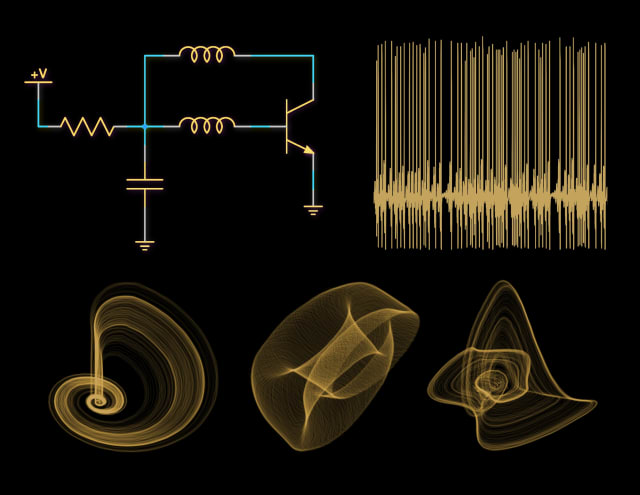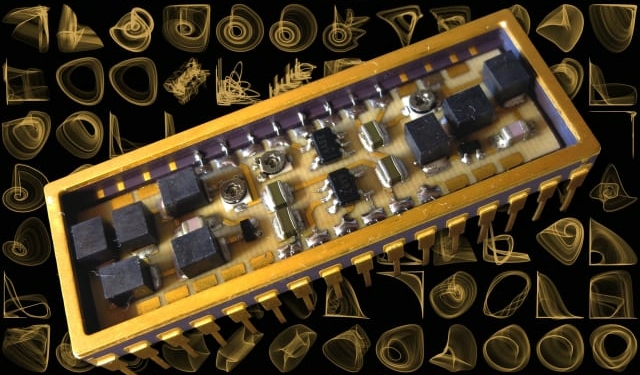source: Engineering.com article
Many simple electronic systems can behave in a difficult to foresee, chaotic manner, as shown by researchers from the Institute of Nuclear Physics Polish Academy of Sciences in Cracow. The image shows a device built from two recently discovered oscillators. In the background are so-called attractors, illustrating the diversity and richness of behaviour of the new circuits. (Featured Image courtesy of IFJ PAN.)
It turns out that many simple electronic circuits behave in an extremely complicated, practically unpredictable manner despite being built of just a few components. Researchers from the Institute of Nuclear Physics of the Polish Academy of Sciences (IFJ PAN) have discovered, examined and described dozens of new, unusual circuits of this type.What’s especially interesting is that one of the circuits generates voltage pulses very similar to those produced by neurons, only it does so a thousand times faster.
Just a few transistors, resistors, capacitors and induction coils are enough to build electronic circuits that behave in a virtually unpredictable way. Even in such simple systems chaotic oscillations of a complex nature turn out to be not the exception but the norm. In a paper published in the journal Chaos, the researchers present 49 new, unusual chaotic electronic oscillators—not designed but discovered by computer simulations.
“Electronics is usually associated with devices that work precisely and always according to expectations,” said first author Ludovico Minati. “Our research shows a completely different picture. Even in electronic circuits containing only one or two transistors, chaos is ubiquitous! The predictable and always the same reactions of electronic devices that we all use on an everyday basis do not reflect the nature of electronics but the efforts of designers.”
In physics, circuits are said to behave chaotically when even very small changes in input parameters result in large changes in output. Since various types of fluctuations are a natural feature of the world, chaotic systems show an enormous wealth of behaviour—so great that precise prediction of their reactions is very difficult, if not impossible. The circuit can thus seem to be behaving quite randomly, even though in fact its evolution follows a certain complicated pattern.
Chaotic behavior is so complex that to this day there are no methods to effectively design electronic circuits of this type, so Minati and his colleagues approached the problem differently. Instead of building chaotic oscillators from scratch, they decided to discover them.
The structure of the circuits, made up of commercially available components, was mapped as a sequence of 85 bits. In the maximum configuration, the modelled circuits consisted of a power source, two transistors, a resistor and six capacitors or induction coils, all connected in a circuit containing eight nodes.
The strings of bits thus prepared were then subjected to random modifications. The simulations were made on the Cray XD1 supercomputer.
“Our search was blind, in a gigantic space offering 2 to a power of 85 possible combinations, said Minati. “During the simulation, we analyzed more or less two million circuits, so an extremely small area of the available space. Of these, about 2,500 circuits exhibited interesting behavior.” Up to now, it seemed that chaotic oscillators occurred in only a few variants, and that their construction required some effort and an appropriately complex system.
Building Chaotic Oscillators
Physicists analyzed the behavior of the new circuits using SPICE, a program commonly used in the design of electronic circuits. However, in the case of chaotic behaviour, SPICE’s simulation capabilities turned out to be insufficient. So, the 100 most interesting circuits were physically built and tested in the laboratory.
In order to improve the quality of the signals generated during the tests, the researchers had to perform delicate tuning of the component parameters. Eventually, the number of interesting circuits was reduced to 49.
The smallest chaotic oscillator consisted of one transistor, one capacitor, one resistor and two induction coils. Most of the circuits found showed non-trivial, chaotic behaviour with a sometimes astonishing scale of complexity. This complexity can be visualized using special graphs – attractors, geometrically reflecting the nature of changes in the circuit over time. Statistical analyses of the signals generated by the new oscillators did not, however, reveal any traces of two important features found in many self-organizing systems: criticality and multi-fractality.

Chaotic voltage changes are common even for electronic circuits made up of only several elements. In the top left corner is a diagram of the simplest chaotic oscillator found by physicists from IFJ PAN in Cracow. On the right, a series of pulses showing a great resemblance to neural activity, generated by one of the newly discovered circuits. In the lower row several so-called attractors, illustrating the complexity of behaviour of the new circuits. (Image courtesy of IFJ PAN.)
“We could talk about multi-fractality if different portions of the voltage variation diagram, magnified in different places in different ways, revealed changes similar to the original characteristics,” said physics professor Stanislaw Drozdz. “In turn, we would be dealing with criticality if the circuit was in a state in which it could at any moment switch from regular to chaotic mode or vice versa. We did not notice these phenomena in the examined oscillators.””Critical systems generally have more opportunities for reacting to changes in their own environment,” Drozdz continued. “So it is no wonder that criticality is a phenomenon quite often encountered in nature. A lot points to the fact that a system operating in a critical condition is, for example, the human brain.”
In fact, one of the found oscillators generated voltage spikes resembling stimuli typical for neurons. The similarity of impulses was striking, but not complete.
“Our artificial neuron analogue proved to be much faster than its biological counterpart: pulses were produced thousands of times more often!” said Minati. “If it were not for the lack of criticality and multi-fractality, the speed of operation of this circuit would justify talking about an electronic super-neuron. Perhaps such a circuit exists, only we have not found it yet. At the moment, we have to be satisfied with our ‘almost super-neuron’.”
The researchers have also demonstrated that they can generate behaviors of even greater complexity by combining the found circuits in pairs. In some situations, the coupled circuits worked perfectly synchronously, like musicians playing in unison, in some one of the circuits took over the role of leader and in still others the mutual inter-dependence of the oscillators was so complicated that it was revealed only after careful analysis of statistics.
In order to accelerate the development of research into electronic systems that simulate the behaviour of the human brain, the diagrams of all the found circuits have been made public.
Anyone interested can download them here.


































